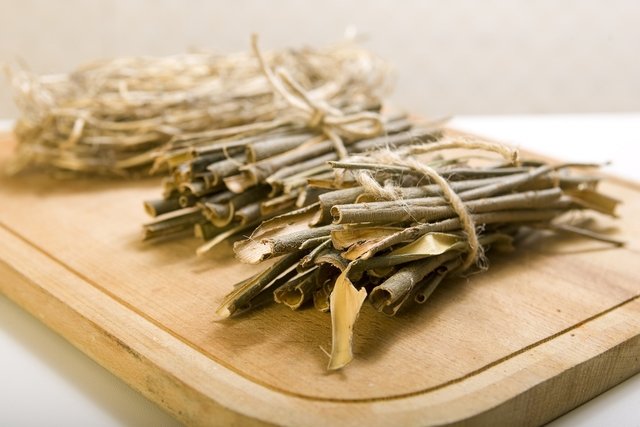White willow is a medicinal plant rich in salicin, a natural substance that is similar to the main ingredient in aspirin and, therefore, has analgesic and anti-inflammatory properties. White willow is popularly used as a home remedy to relieve headaches, fever and pain caused by inflammatory problems such as muscle strains, rheumatoid arthritis or osteoarthritis, for example.
The normally used part of white willow is its bark, generally for the preparation of teas, however, it can also be found in the form of capsules prepared with the dry extract of the bark.
The white willow, whose scientific name is Salix alba, it can be found in herbalists, health food stores or compounding pharmacies, and should be used with the guidance of a doctor or other health professional who has experience with the use of medicinal plants.

What is it for
The properties of white willow include its sweating, antipyretic, analgesic, anti-inflammatory, antirheumatic and anticoagulant action, and is normally indicated for:
- Fever;
- Flu and colds;
- Headache;
- Rheumatism;
- Arthritis;
- Arthrosis;
- Osteoarthrosis;
- Drop;
- Muscle pain;
- Back pain;
- Muscle strain or strain.
Although it has health benefits, the use of white willow does not replace medical treatment and should only be used under the guidance of a doctor or herbalist.
How to use
Willow is generally used in the form of tea or capsules:
1. White willow tea
To prepare white willow tea, you must use the bark of this plant from which the main active substance, salicin, is extracted.
Ingredients
- 1 teaspoon of dried and chopped willow bark;
- 1 cup of water.
Preparation mode
Bring the water to a boil and add the willow bark. Let it boil for 10 minutes, strain, wait for it to cool and drink up to 2 cups a day, preferably after meals.
2. Willow Capsules
The willow capsule should be taken orally, with a glass of water, after meals, and the normally recommended dose is 1 capsule of 400 mg, 1 to 2 times a day, or as directed by your doctor or healthcare provider. herbalist.
Possible side effects
White willow is relatively safe when used for a maximum of 12 weeks of treatment and in recommended quantities, not exceeding 1 to 3 g of bark in the form of tea or capsules per day.
However, willow can cause side effects such as diarrhea, heartburn, stomach pain, nausea, vomiting or bleeding.
Due to the presence of salicin in its composition, which has an anticoagulant action like aspirin, white willow may increase the risk of bleeding. Therefore, it should not be used by those with health problems that increase the risk of bleeding, such as gastric ulcers, esophageal varices or hemophilia, for example.
Who shouldn’t use
Willow should not be used by children, pregnant or breastfeeding women, or people who are allergic to aspirin.
Additionally, willow should not be taken in the following situations:
- Tendency to bleed;
- Asthma attack induced by the use of aspirin or other non-steroidal anti-inflammatory drugs;
- Active stomach or intestinal ulcers;
- History of ulcers in the stomach or intestine;
- Gastritis;
- Gastroesophageal reflux;
- Colitis, diverticulitis or diverticulosis;
- Severe kidney, liver or heart failure.
Furthermore, white willow should also not be used by people taking aspirin, methotrexate, anticonvulsant medications such as phenytoin or valproic acid, or oral anticoagulant medications such as warfarin, for example.
It is important to inform your doctor and herbalist about all the medicines you are using, as willow can interfere with the effect of several medicines and cause serious side effects.
Bibliography
- NIEMAN, DC; et al. A commercialized dietary supplement alleviates joint pain in community adults: a double-blind, placebo-controlled community trial. Nutr J. 12. 1; 154, 2013
- GAWLIK-DZIKI, U.; et al. Bioaccessibility in vitro of nutraceuticals from bark of selected Salix species. ScientificWorldJournal. 2014. 782763, 2014
- VHURUBASIK, S.; et al. Treatment of low back pain exacerbations with willow bark extract: a randomized double-blind study. Am J Med. 109. 1; 9-14, 2000
- OLTEAN, H.; et al. Herbal medicine for low-back pain. Cochrane Database Syst Rev. 2014. 12; CD004504, 2014
- SHARA, Mohd; STOHS, Sidney J.. Efficacy and Safety of White Willow Bark (Salix alba) Extracts. Phytotherapy Research. Vol.29. 1112-1116, 2015
- CHURUBASIK, S.; et al. Treatment of low back pain with a herbal or synthetic anti-rheumatic: a randomized controlled study. Willow bark extract for low back pain. Rheumatology (Oxford). 40. 12; 1388-93, 2001

Sign up for our newsletter and stay up to date with exclusive news
that can transform your routine!
Warning: Undefined array key "title" in /home/storelat/public_html/wp-content/plugins/link-whisper-premium/templates/frontend/related-posts.php on line 12
Warning: Undefined array key "title_tag" in /home/storelat/public_html/wp-content/plugins/link-whisper-premium/templates/frontend/related-posts.php on line 13



